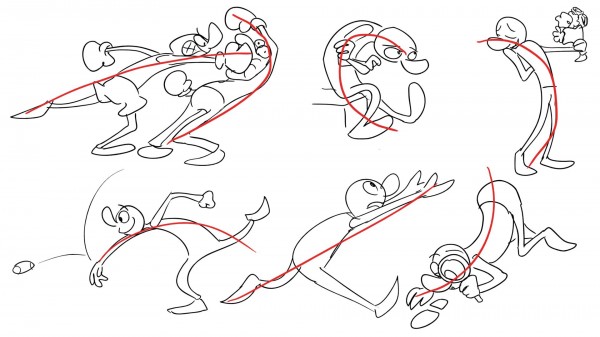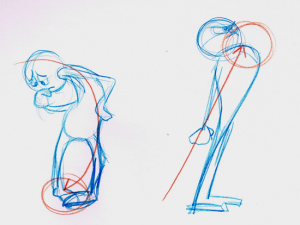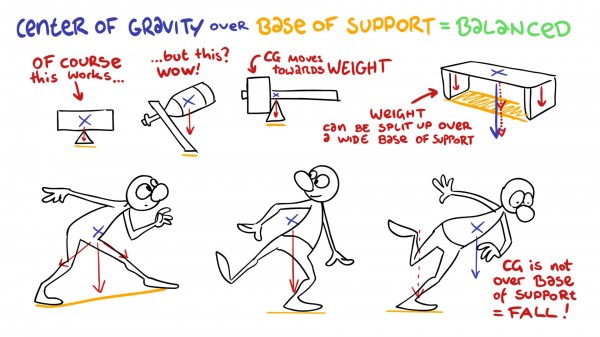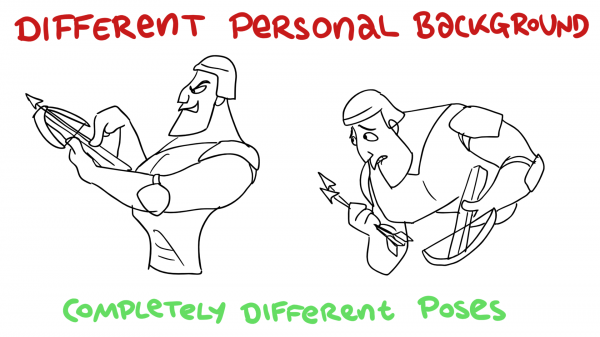Perfect Posing – 1 – Listen to the character… and to physics
Posing a character in a readable, appealing way that conveys the desired action and emotion at one glance is a high art. In this series of articles, we will have a look at what makes a good pose great, give suggestions on how to optimize the posing process, plus provide some tips and tricks on how to avoid common mistakes.
Posing a character is the core of a character animator’s work. While many basic rules about arcs, anticipationPreparing a motion by first going into the opposite direction to build up momentum is called anticipation. The anticipat... More, timing and spacingSpacing is the distance an element travels between two frames of an animation. By increasing and decreasing the spacings... More can be learned and applied without much thought, posing characters with different character traits, abilities and body types in different situations and emotions is (as it should be) a new challenge every time. Every new scene, every new character demands fresh ideas and great visual skills – the search for improvement is never complete.
Let’s try to define what good posing calls for, so we have a more objective basis to judge if a pose works or not:
Good posing…
- conveys the action that a character is doing (what is being done)
- conveys his emotions and feelings (how it is being done – happily, sadly, confidently,…)
- conveys his motivation (why it is being done)
- takes a character’s body type (light, heavy) into account
- feels natural and is not forced onto the character
- must be clear and easy to read with one glance
- must be appealing to look at (rhythm and flow, straight against curve)
- leads from one pose to another and tells the story without any inbetweens and annotations
This week, we will have a look at how a character’s physical attributes, emotions, as well as “invisible” aspects like character traits and thoughts, have to find their way into the pose in order to make it believable and meaningful.
Action and energy
Everybody is always doing something. Even characters that don’t move are still “living” creatures and therefore have thoughts and feelings.
These actions (however small and internal they may be) have to find their way into the character’s posture. You need to show what the character is doing, thinking and feeling. Sounds simple and logical, but making a pose seem physically believable alone can be quite tricky.
What makes this so difficult? Every motion requires kinetic energy (remember science class?). But what we really have here when animating is a bunch of still lines, computer generated pixels or stiff puppets that we somehow need to charge with this energy in order to convey believable action. A common mistake is to think that kinetic energy comes just from getting these lifeless elements to move around by putting a sequence of frames together. This can make them move, but if you can’t convey correct physical forces in a single image, it won’t feel right in the moving pictures. This (and later on the spacingSpacing is the distance an element travels between two frames of an animation. By increasing and decreasing the spacings... More of the frames) is what gives your characters weight and energy.
Line of action
So, how do we get energy into a pose? It can be very helpful to work with a line of action.
The line of action visualizes the main flow of energy through a body. In general, there is only one big main action that needs the support of the whole body (even more so in those cartoons that require stylization and exaggeration). These forces are not directly visible, but you feel them in the well-crafted still image; how the whole body is pushed or pulled, and from where to where the energy is channeled. The line of action is the tool of choice to make this energy clear. Generally, the line of action should be bent to give the the impression of energy flowing from one point to another.
INSIDER TIP!
It’s often taught to draw the line of action first and then the character around it. Personally, I disregard this practice, because it tends to make the pose stiff if it is forced. Rather, I scribble until I find a pose that already seems to have a good flow of energy to me, then draw the line of action on top of it, and emphasize it in my next thumbnail.
Power center
As if all this isn’t complicated enough, a character’s pose (and motions) tend to have one specific power center that pulls or pushes a character, which often causes a curve in the line of action. Usually, the power center is placed in a body part (often the hips, head, chest or arms), but it can also be outside of the body, causing an extra dragLoose, attached parts tend to start moving with a delay and lag behind because of inertia. This is clearly visible at th... More or push, almost as if the character were on a string. A power center can also be a fixed character attribute that rarely changes (think about Goofy stumbling into chaos head first).
Sometimes it can also shift within the story or even a single scene. For example, when a character gains back self-confidence, the power center could move from the ground next to him, all the way up above his chest.
Remember, if the power center cannot be felt in the still image, it will not be there in motion either.
Gravity, weight and balance
While the line of action and the power center are the forces that are mainly influenced by your character and his action, a big, undeviating outside force is already pulling on him: We constantly fight against gravity – we have to actively maintain balance or else we will fall over. Think about how long a baby needs to master standing up and walking – this is highly complex stuff.
Everything has a center of gravitythe center of the average mass distribution. This point needs to be above a base of support of a character to keep the b... More (CG). This is the average position of an object’s weight distribution. It is the single pivot point which would allow an object to retain its balance when lifted into the air if only this point is supported (think about those toy eagles that you can balance on you finger). The CG shifts to where most weight is located. The area with contact to the ground is called the base of support. If the CG is over the base of support, the object is balanced. If not, the object falls towards the CG. A base of support doesn’t have to be entirely solid, e.g. a wide base of support can included the area that is spanned between two legs.
However, this does not mean that your character has to maintain balance at all times. While it is common that key posesKey poses are the most important poses of an animation. Every single one is needed to understand and advance the story. ... More are held for a while, and therefore have to be balanced, many short breakdownA breakdown is a pose at the turning point of a motion path - often during the fastest moment of a motion. It's often se... More moments (the middle position between two keys) only really work when they are off balance. A very important one of these is in a walk cycle right after the pass position – for a short moment we fall forward, until the foot that was in the air touches the ground.
The center of gravitythe center of the average mass distribution. This point needs to be above a base of support of a character to keep the b... More is also a great tool to distribute the body’s weight onto the legs properly. Usually, one leg holds most of the weight near the CG and the other one is just supporting, extended out to widen the base of support.
From time to time, we shift our weight from one leg to the other. This can add some great realistic variation to the poses – especially when the weight shift happens in connection to actual changes in the character’s thinking or dialog.
Of course, gravitational pull doesn’t just stop with holding our legs to the ground; remember it applies to the rest of the body as well. The amount of weight given to individual body parts will vary greatly depending on the character’s body type. Heavy-set characters will tend to have heavier looking limbs too, rather than just a heavy looking gut. Always check that gravity is applied to the character’s individual parts, as well as the body as a whole. This will help create a sense realism in the character’s movements.
Characters with different body types deal with physical forces (gravity, impact of a hit) and energy (movement, anticipationPreparing a motion by first going into the opposite direction to build up momentum is called anticipation. The anticipat... More, emotional build-up) differently. A large, heavy character gets dragged much more by gravity; his mass pulls him firmly to the ground. At the same time, he needs to build up a lot of energy to move. He is pretty much unstoppable once he has gained momentum or falls, because he gets pulled further by his own weight.
There is still a lot of room for variation here, though. One large character might appear absolutely clumsy, having difficulties keeping his body balanced, while another might be a skillful fighter who knows how to put his weight to use in a battle.
A light character, on the other hand, could switch directions much more often, because he doesn’t need to build up as much energy, and therefore could appear flexible and energetic. Or, perhaps, he cannot build up much energy at all, creating a weak and lanky impression. Note: A character’s body type is not automatically defining his character.
Emotion & motivation
So, we’ve established that good posing has to show what action a character is doing, and is influenced by his body type and his way of building up energy. But another very important thing that we have to reflect in a good pose is something that has much less to do with physical appearance or a concrete activity. The pose is also highly influenced, if not completely changed, by what a character is thinking and feeling at this moment in the story, what has happened to him in the past, as well as by his general character traits, principles and attributes (strengths, weaknesses, fears, dreams).
Picture how a skillful, ambitious warrior readies his cross-bow, eager to win the battle. And now we can take that same model sheet and give him a different background-story, emotion and motivation. He now is a pacifist being forced to be a soldier by his family’s expectations. He is doing the same thing as before, but his attitude, and therefore his pose, is completely different.
Isn’t that amazing? Different emotions, background stories and motivations completely change the line of action and the power center of the same body type. So, the inner processes are tremendously important for the pose. Can you see how it can also make a huge difference at which point in the story the character does something, e.g. if he gained his self-confidence yet or not? A believable motivation is what really makes your character come alive.
Sometimes the line of action is completely determined by the emotion, because there is just not enough of an action. Look at these characters:
They could all… let’s say… be waiting to see the dentist, yet they each have a different pose. Each one of them has a different character, different experiences, emotions and expectations, which changes the pose.
It’s getting really tricky if a character tries to hide his true feelings, in which case some part of the body or facial expression must show the truth, and some must show the pretended emotion (think of Scar as he is lying to Simba about the elephant graveyard). Another possibility would be to show one pose with the true emotion and another with the facade — close together, but separately.
Have a look at this article, which further discusses how poses for the same action differ vastly depending on a character’s emotion, motivation, background-story and prior events. Read on here to explore how emotions are the driving factor for any story and every action.
Next week…
This week we saw how the character’s physical features, as well as inner processes, attitudes and emotions have to be regarded in posing. Next week, we will focus on recommended visual guidelines and aesthetic aspects, that can make your poses more appealing and interesting. Click here to read Perfect Posing 2 now!

















I can never figure out how to get the character to look balanced in Maya. Any ideas? It is like he is floating.
Check out your centre of gravity and use the motion trail to see the characters forward tragetory. Breaking tangency handles on the root translation keys will help create a sense of weight onthe contacts.
Hope this helps.
can’t wait for part 2!!
Posing is hard. How do you make it so that it doesn’t break your model but is still a good pose?
@Jordan Horne I hear you on that one, it is tough. What I usually do is if I need a certain pose I will ignore the rig and just deform the model to get it right to the camera I’m using. It will break in places, but if you don’t see it who cares?
I’m impressed, I must say. Really rarely do I encounter an article that is both educative and entertaining, and let me tell you, you might have hit the nail on the head
Thanks for this website, especially this current article, it is a refuge from the storm!
I especially appreciated the power center theory, the lack of that confused my posing!
Onward and Upward!
When is part 2? When when when! 🙂
Now! 😀
https://www.animatorisland.com/perfect-posing-2-appealing-and-readable/
I can’t decide how much I love this site!
I am extremely inspired with your writing. keep up the nice quality writing, it is rare to look a nice blog like this one today.
Very helpful stuff thank you!
you might have a great one here! I also like part 2 that you just did thank you.
This article infused posing into my head. I’m always thinking about it. Posingposingposing. Thanks!
great post!
Dude. This site is amazing. Keep going!